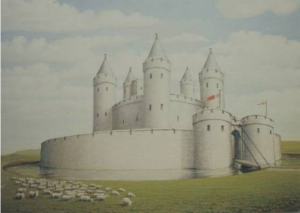Roger Chamberlain
Sir Roger Chamberlain

Sir Roger Chamberlain , is one of my favourite characters in this story, as he has an interesting back story.
Background
Roger, as far as I can make out, was born about 1410. How he got to be with Humphrey, Duke of Gloucester (the kings uncle) I have yet to find out, but he was his confidant and some sources say his chamberlain (which is appropriate due to his name).
Queenborough Castle

In 1441, the Duke made Roger the constable of Queenborough castle, on the Isle of Sheppey. Queensborough castle was built (in 1367) for the protection of the realm and was situated at the confluence of the River Medway and River Swale. This castle was unusual as it was a circular keep, surrounded by circular walls. Unfortunately, this castle no longer exists, as it was demolished after the civil war.
The castle was part of a time team investigation in 2006 and is well worth a watch (Time Team – Series 13 Episode 8 – “Castle in the Round”).
Treason
In February 1447, at the height of the conflict between Gloucester and Suffolk, the Duke and his followers were arrested for treason. They were accused of plotting to make the King release Eleanor Cobham (the Dukes wife who was arrested for witchcraft in 1441) and marching with a force, to overwhelm parliament at Bury. The Duke died very soon afterwards, possibly of natural causes (Stroke) but the rumours of possible murder, would not go away.
The death of the Duke of Gloucester, probably helped Roger.
Execution …….almost!
The Duke of Suffolk was one of the people who heard Roger’s indictment (along with the others arrested), and he wouldn’t have been an unbiased councillor. Roger was found guilty of treason and was ordered to be executed by drawing, hanging and quartering. Roger was drawn, hung and cut down and a knife put to his flesh and with dramatic license, the Duke of Suffolk stopped the execution with a charter, from the King, which forgave them all. The mental torture Roger went through is normally only seen in the realms of modern movies.
By October, Roger seems to have gone back to being the constable of Queenborough castle, after vowing fealty again to the king, I should have imagine. Without his feudal guardian, I expect the Suffolk clique were unworried about him, as he was no longer in a position of influence.
Roger “The Fence” Chamberlain
At the time of the Jack Cade rebellion in 1450, there must have been a meeting between Roger and Cade, or his captains, as when Cade took control of London, Cade sent the booty from the expedition to Roger to be stored in the castle. Perhaps the two sides never met, but perhaps the local mayor, John Cokeram, (who was on the list of pardons afterwards), might have persuaded Roger to help for Cade.
I expect that Roger, after his mock execution and the death of his feudal lord, would have gone along with the plans. After the rebellion, when Cade came for his ill gotten gains, Roger refused, probably aware that the status quo had not been changed as he hoped, didn’t want to be on the wrong side. Cade, with some men, assaulted the castle without any result. Roger on the other hand captured two of Cade’s men, Geoffrey Kechen and Captain Butcher
Aftermath
Roger, advised the King of all the items held in the castle. The king ordered the return of the stolen goods back to London, and sold them back to the people who lost them (nice).
Possible Connection
Although I cannot find a link to a Roger Chamberlain from Gedding, in Suffolk, it would be nice. This Roger was Sheriff of Norfolk in 1440 and became MP for Gedding in 1455, with the help and support of the Duke of Norfolk – a mainly Yorkist supporter.
As I have said there is no solid evidence that I can find that the two Roger Chamberlain’s are the same – it’s just more of a hope.
Additional – It does Seem as if Ralph Griffiths, the author of “The Reign of King Henry VI” (isbn 510-26261-9) Seems to have made the same connection, so I am happy with this connection (he’s far more eminent than me).
